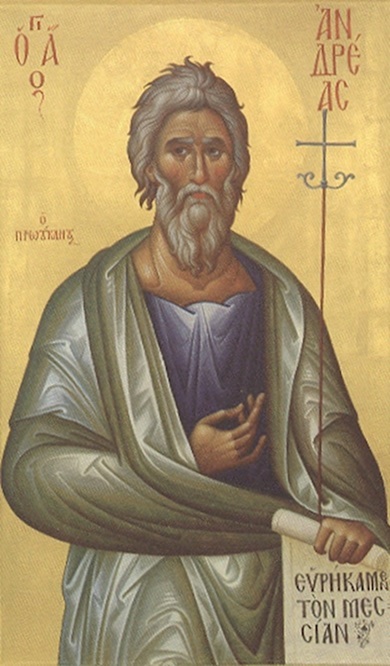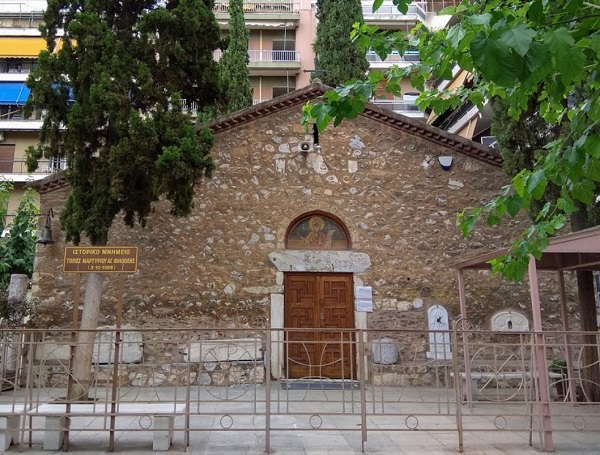Andrew the First-Called. The Life of a Blessed Martyr
29 November 201930 November is the feast-day of the Holy Apostle Andrew the First-Called. All the Apostles died martyr’s deaths [1], preaching the Gospel in various countries. Only one was martyred in Greece, Saint Andrew the First-Called, that is, the first who went to be with Christ. He was martyred in Patra. The city is greatly honored by being counted worthy for its earth to be soaked with the blood of him who Christ called before the other eleven, before his brother Peter.

Initially, Andrew was a disciple of Saint John the Forerunner. One day, the Baptist was sitting with his two disciples and he saw Christ walking in the distance. He turned to them and said: ‘Behold, the Lamb of God’. When the two disciples heard their teacher speaking in this way, they went after Christ. He saw them following, turned and asked them what they wanted. They asked Him where he was staying and He told them to come and see. So they went with Him and stayed the whole day. One of these two was Andrew. It’s clear that the other one was John, because what we’re written above is narrated by John himself in his Gospel (1, 35). He also says: ‘One of the two who heard John [the Forerunner] and followed him was Andrew, the brother of Simon Peter’ (1, 40).
You see how he conceals the fact that he was there with Andrew. He does so out of modesty and not only in this part of his Gospel but in others, as well. And although he’s usually sparing with the details of his narrative, at this point he even records the time when they went to meet Christ. It appears that the moment when he first met his beloved Teacher [2] was imprinted on his soul. So he writes: ‘It was about the tenth hour’ (1, 39).
Later, Andrew goes and finds his brother Peter, who was still known as Simon and says: ‘We have found the Messiah’, which being interpreted is ‘Christ’ [‘the Anointed One’]. He took him along to Christ. When Jesus turned and saw Simon, He said: ‘You are Simon, the son of Jonah. Your name shall be Cephas’, which means Peter [Rock].
Andrew was born in Bethsaida in Galilee, a fishing village built on the shores of Lake Gennesaret [Galilee]. According to what we’ve written above, Peter was the brother of Andrew and both were sons of Jonah, a fisherman. Peter was impetuous by nature and easily roused, but Andrew was quiet and didn’t speak much. As Saint Epifanios writes: ‘Peter was very warm-spirited and well-versed in the duties of the world, whereas Andrew was meek and spoke little’.
From the Gospel, it appears that Andrew was among the Lord’s disciples who could be more familiar with Him, as were Peter, John and Philip. But still, he never seems to have spoken much. On the day when a host of people gathered to hear Christ teach, and were hungry, Christ turned to Philip and asked where they could buy bread for them to eat. Philip replied that it would cost a great deal of money to give each of them just a bite. Then Andrew said: ‘Here is a boy with five small barley loaves and two small fish [3]’ (John 6, 5-10).
Again, on another occasion, on the day Christ entered Jerusalem with the palms, some Greeks wanted to see him and went to see Philip saying ‘Sir, we’d like to see Jesus’. Philip told Andrew and then they both went to tell Christ. Christ then said: ‘The time has come for the Son of Man to be glorified’ (John 12, 23), in other words that the time had come for the Gospel to be preached to the Gentiles. Do you see? Again Andrew spoke to Him. My conclusion is that the Greeks [i.e. ‘idolaters’] went to Philip because he had a Greek, Macedonian name. He told Andrew, who also had a Greek name and perhaps knew the language [4]. Of the Twelve Disciples of Christ, only these two had Greek names.
After the Resurrection, the last time that Christ appeared to His disciples was when He told them: ‘Go and preach to the nations, baptizing them in the name of the Father, Son and Holy Spirit, teaching them to observe all that I have commanded you. And behold, I am with you all the days until the end of the age’.
Once they’d received the Grace of the Holy Spirit on the day of Pentecost each of them made their way to different lands, as the Spirit moved them. According to tradition, Saint Andrew first went to the Black Sea region. He preached the Gospel in Trebizond and Amisos [Samsun] together with certain others of the seventy apostles and brought thousands of Jews and Greeks to the religion of Christ. From there he went to Colchis, today’s Lazistan, which was inhabited by the fierce corsairs known as the Kerketes (Cercetae).
Thereafter he returned to Jerusalem to see his brother Peter and the other apostles, then left for Ephesus with Saint John the Theologian. While at Ephesus he saw Christ in a dream telling him to go and preach the Gospel among the Scythians. On the way to Scythia, he went through Bithynia and preached in Nicomedia, Chalcedon and Pontic Heraclea. He then crossed over into Paphlagonia and preached in Amastris and Sinope, where he baptized many Christians and then went back to Amisos and Trebizond. From there he went to Samosata, on the River Euphrates, and taught the Greeks, of whom there were many in those parts.
From Samosata, he returned to Jerusalem and this time met Paul. After the Passover he left again and, via Cappadocia and the lands of the Laz people, reached Kiev in Scythia, the Pantheon of Slavonic polytheism. On a low hill he set up a stone cross. He then crossed the Caucasus and the Caspian Sea and preached in present-day Khorasan. He then returned west and arrived in the Crimea, where he taught and baptized many. He visited Sinope, then went on to Byzantium, which was then a still a village, since Constantinople had not yet been built. He consecrated Stachys, one of the seventy as bishop, and then continued into Thrace and today’s Bulgaria and Serbia.
After that he went down into Macedonia, Thessaly and Roumeli, and from there continued to Moria and Achaia, the capital of which was Patra, a large city honored by the Romans, who at that time lorded it over the whole world. The city had more than its share of official buildings and statues. The Proconsul at the time was one Aegeates. It soon became common knowledge that Andrew had cured many of the sick merely with the touch of his hands and people flocked to him. As it happened, just then the wife of Aegeates, a woman called Maximilla, also fell ill and Saint Andrew cured her. A short time later, Aegeates went to Rome to present himself before the emperor, Nero, on imperial business and he left behind his brother Stratocles in his place. This Stratocles was a wise man, renowned in Athens for his mathematical knowledge. He had a slave, Alcamanas who was cured of lunacy [epilepsy] by Saint Andrew. Both Stratocles and Maximilla believed in Christ and were baptized, as were many other people with them.
When Aegeates returned to Patra and learned what had happened, he ordered Andrew’s arrest and he was thrown into prison. A few days later, after a trial, the verdict was that he was condemned to be crucified. Before his arrest, he’d consecrated Stratocles as bishop.
At dawn on the day of his execution, the Roman soldiers tortured Andrew and took him down to the shore, to the place where his church is today, but which was occupied in those days by a temple to Demetra. He turned, looked impassively at the cross, blessed it and the people, and submitted to crucifixion. He was by then an old man, over seventy. The cross on which he was martyred was made of two equal planks in the shape of a saltire (X) and, according to tradition was of olive wood.
He was martyred at the time when Nero was emperor in Rom. According to Saint Epifanios, ‘he was a well-built man, a little bent, a slightly hooked nose and thick eyebrows’. His body was buried by Bishop Stratocles and Maximilla and the funeral was attended by a great many people. He was embalmed with precious ointments and his placed in a marble tomb near the sea. The tomb is still there, within his church, but his holy relics aren’t, because 350 years after his martyrdom, they were removed to Constantinople and placed in the church of the Holy Apostles, together with the other disciples of Christ.
In 1204, the Frankish Crusaders arrived in Constantinople and seized whatever they laid their hands on. A certain Cardinal Petrus, from Capua, took the relics of Saint Andrew to Amalfi, in Italy. He built a magnificent church in memory of the saint and, in a great procession, placed the relics there, in a silver case, on 8 May 1208.
All that remained in Patra was his holy skull, which had been given to the people of Patra by Emperor Vasilios the Macedonian. But in 1460, when the Turks invaded Moria, Thomas Palaiologos, the brother of Konstantinos and last governor of Patra, took the holy skull and sent it by ship from Pylos to Rome where he gave it to Pope Pius II [5]. His cross is in Marseilles, in the Monastery of Saint Victor.
In Patra and the surrounding towns and villages there were a great many churches dedicated to Saint Andrew, though none of them have survived until today. Today’s church is a basilica of the type we’re used to seeing in the Ionian Islands and was built in 1845. The ceiling was painted by Dimitrios Vyzantios, who wrote the Babylonia and was an iconographer. Despite the fact that the church is neither built nor decorated in the Byzantine manner, it is still a prayerful location.
On the other hand, the half-finished church nearby is a monstrous creation and ought to be pulled down by the people of Patra. I know that they’ve been tormented for years now without being able to come to an agreement on the plan for the large church that they want to build. I’ve seen the plan sketched by some Frenchman and it’s nothing but an ice-cream cake. How difficult can it be? Commission somebody who has some idea about things Byzantine to build a small church, a faithful copy of one of the most beautiful Byzantine churches, such as, for example, Saint David’s in Livadia, Vrontokhi in Mistras, a church in Thessaloniki or on the Holy Mountain. Patra is the port of Greece, looking out onto the European sea and, if you’re coming in from there, it’s shameful that your first sight should be a Frankish church on the site where Saint Andrew was martyred. There should be a Greek, Byzantine church there. What are you doing sitting around talking for so many years when you’ve already got the best resources available locally?
Here in Athens I painted the icons for a small, old church dedicated to Saint Andrew, on Lefkosias Street, near Agamon Square. It was a lot of work. But when the painting was finished, I think it was a little museum of Byzantine iconography.

The small church dedicated to Saint Andrew on Lefkosias street






